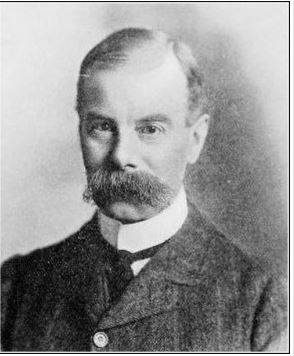
John was born on the 8th August 1855, the only son of Robert and Mary Lodge of The Rookery Bishopdale near Aysgarth. He was educated at St. Peter’s School, York and Gonville and Caius College, Cambridge. He graduated MA in 1879 and was called to the Bar at the Inner Temple, London in 1883.
At 18, John had joined the 5th West York Militia, which became the 3rd Battalion Yorkshire Regiment in 1881.
He would serve with the battalion in the 2nd Boer War (1899-1902). The Aysgarth parish magazine of June 1902 reported on his return from two years’ active service.
“A large and enthusiastic crowd met him at the station, the West Burton Band playing appropriate airs. After much hand shaking and cheering, Mr Tomlinson in an admirable speech welcomed Colonel Lodge back to Wensleydale… After Colonel Lodge replied, giving a most interesting sketch of what he had had to do in South Africa, the band headed the procession from the station, Colonel Lodge riding in a wagonette with his sisters.”
From 1906 until retirement in 1912 he would be the Battalion Commander. At the outbreak of the First World War, John offered his services and returned to his old Battalion as Major, remaining with it until May 5th 1916 when he was appointed to the command of a Garrison Battalion.
As Squire of Bishopdale, Colonel Lodge was a Justice of the Peace for the North Riding and was on the Yorkshire Fisheries Board. He was a skilled angler and marksman. John never married. He died at home after a short illness on the 23rd August 1917 aged 60.
John Lodge had been associated with the Yorkshire Regiment for 43 years.
In October 2021, a portrait of John Lodge was donated to the museum. Read the story here.
Explore more memories from the ribbon
-
Herbert Mills
Submitted by John H Mills – who wanted to tell the story of his grandfather. Herbert Mills was born on 16th May 1879 in Huddersfield, Yorkshire, four months before his parents were married. Shortly after the marriage his mother and father separated his father got into trouble with the Law, abandoned them and departed for America. Herbert and his mother went to live with her parents. In 1891 he was still living with his grandparents and in 1911, age 31, he was living with his Aunt (his mother’s sister). He married in 1913 and had a son in 1914. His son went on to join the RASC in 1939. Herbert, age 35, volunteered in Lord Kitchener’s “Volunteer Army”. He had been married less than two years and had a one year old son. He was a Power Loom Weaver in a woollen mill. He enlisted in Huddersfield on 4th June 1915. His Attestation puts him in the Royal Army Medical Corps as a Mental Assistant and posted to RAMC 92nd Field Ambulance Unit, Crookham, Aldershot. He was posted to the, 15th Northumberland Fusiliers in August 1915. From August to September 1915 he was stationed at Hamersley, Physical Training Base Aldershot, and from September 1915 to March 1916 at Rugeley Camp, Cannock Chase. Rugeley Camp was a training camp which replicated the trenches in France and was used for training soldiers prior to embarking to the Front Line. He was promoted Corporal in November 1915. In March 1916 he was posted…
-
Mary Devas Marshall MM
Mary Wilkinson (née Marshall and usually known as Molly) died in Winchester in 1983 at the age of 90. Mary had originally enlisted in the First Aid Nursing Yeomanry in 1912. On the outbreak of the First World War she was initially refused permission by the British Authorities to go to Belgium and so it was under the jurisdiction of the Belgian Government that she made her way across the Channel. Her medals, testament to her work during the war, are displayed in the museum’s Medal Room alongside those of her husband, Captain Wilkinson. Few FANYs, let alone women, were decorated with the Military Medal, an award earned while she was based at the hospital at Marquise in the grounds of the 1st Aeroplane Supply Depot. This location saw the most devastating German aerial attack of the war on an aviation facility. The citation for her Military Medal states “For gallantry and coolness during a bombing raid by hostile aircraft….she displayed the utmost disregard of danger, attending many serious wound cases which required skilful and immediate assistance.”
-
K R Henderson
Kenneth Henderson was born on the 29th May 1895 at Sutton in Surrey, the third and youngest child of Robert and Janie Henderson. His father was a bank manager. The family were quite reasonably well off as the 1911 census shows the family having 3 servants. By this time Kenneth was at Charterhouse School. His early life is undocumented. On the outbreak of WW1 Kenneth enlisted in the 28th Battalion, The London Regiment (Artists’ Rifles). This was a popular unit for volunteers and a number would be selected to be officers in other Regiments, as Kenneth would be. On the 26th October he landed in France with the Artists’ Rifles and on the 15th March 1915 was made temporary 2nd Lieutenant with the 2nd Battalion, Yorkshire Regiment. During 1915 he saw action with the 2nd Battalion at Fromelles, Festuber and Givenchy. On the 7th July 1916 during the Somme offensive he received his fourth wound of the war. After the war he was with the newly reconstituted 6th Battalion, Yorkshire Regiment, for service in the Russian Archangel campaign. It was here that he received the Military Cross. The London Gazette of the 21st January 1919 read: ‘He has carried out the duties of a Company Commander of a mixed force at Bolshe-Ozerki and has worked in a very efficient way. He has had continuous service on this front since November 1918 and in four engagements in which his company has taken part he has proved to be a fearless and…
